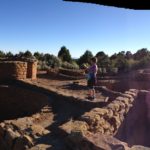
Ruins. All that remains of a culture that lasted continuously for over 700 years at Mesa Verde. Like a skeleton, its bones and articulations telling a rich story, from a nomadic people tired of wandering, to a frightened and fighting society starved into leaving for kinder territory in Arizona and New Mexico.
When I was a kid, I loved ruins, ate up archeology, and in some ways, even now, am as much a cultural anthropologist as therapist. I am a social worker, and one of our credos is person-in-environment. Visiting Mesa Verde with a dear old friend a few weeks ago, my inner anthropologist was in spasms of joy, puzzling out all the unexplained clues left by the Anasazi. Who were these people, what was the impact of the environment on them, and vice-versa?
In particular, what was the role that hardship played in turning spirituality into religion?
When I think of spirituality, I think of an ecstatic dance, a moment of grace and deep understanding. It is as easy for me to conceive of hugging a tree in order to induce this state, as pray to some symbol of divinity. Spirituality is felt in our senses. Our hearts burn, our limbs lighten, our mouths lift softly at the corners, our bellies engage and expand. Despite the new age adage that we are spiritual beings living in a material world, I think that in these moment, matter and energy become one.
How different, then, from the lock-step of religion! The rules and practices that intend to better us, born of some miserable social circumstance—slavery, poverty, and the inequality that bore them – reminding us of how much improvement we require. I think I have a sense of how one can become the other, and I’ll need to tell it to you as a story, a story I’m making up using Mesa Verde as my vehicle.
In the beginning, there was fear. Nomads without a home, without any form of security, settled over a millennium ago on the verdant top of a low mountain range. From here, they could see the threatening approach of predators, and the flow of life-giving water, the presence of game. Here they dug in, literally, creating pit houses in the earth, cool in summer, warm in winter, and began cultivating. Spirituality thrives in safety, and as fear receded, in my story, people were able to enjoy, and at every moment of every day, be surrounded by the natural and nurturing energies of wind, rain, earth, and clean fragrant air (the sage still grows in abundance there). How can one not be spiritual under these circumstances? With humans as just one more, albeit intelligent, animal in the spiral of life, we learned to work with the seasons, as well as the other life forms, to survive cooperatively, and in my story, relying as much on an intuitive sense as on trial and error to improve, over time, those cooperative systems.
The ruins support my story, at least a little. Those pit houses morphed into two separate kinds of structure. The first became private quarters, made of mud and stone (therefore nonflammable), in which one slept, dressed, and committed other private acts; the second was where one would spend far more time: the Kiva. Dug deep into the earth, lined in stone, covered by a tapestry of tree limbs and adobe, these kivas were sanctuaries, common rooms, living rooms, warming huts, ritual spaces, all for the drawing together and coordination of the inhabitants. And for about 600 years, this was plenty good enough. While improvements happened over time, nothing suggested that they were made to correct some deep flaw in our characters, and a happy integration persisted between spiritual and practical living.
Next week: One woman’s story (mine) of how spirituality descended into religion…
